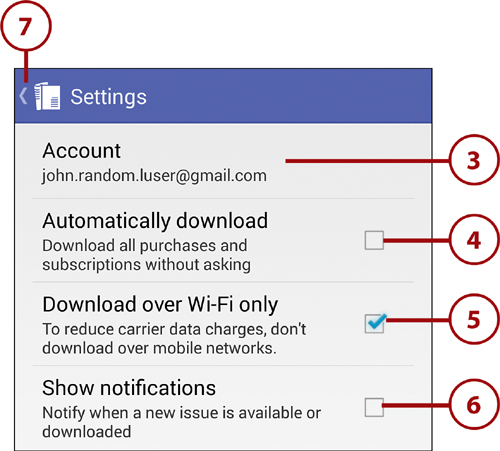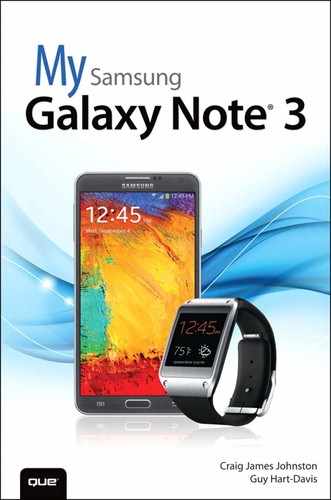10. Books and Magazines

In this chapter, you discover your Galaxy Note 3’s capabilities for carrying and displaying books and magazines. Topics include the following:
→ Reading books with the Play Books app
→ Installing and using Amazon’s Kindle app
→ Finding free e-books online
→ Reading magazines with the Play Magazines app
With its large, bright screen, your Galaxy Note 3 is great for reading books and magazines. You can load an entire library and newsstand onto your Galaxy Note 3, take the device with you anywhere, and read to your heart’s content.
Reading Books with Play Books and Kindle
Books are perfect media for your Galaxy Note 3 because their file sizes are mostly small but they deliver long-lasting entertainment. Your Note 3 likely comes with one or more apps for reading books, but you will probably want to supplement them with other apps, such as the free Kindle app from Amazon.
Open the Play Books App and Meet Your Library
Google’s Play Books app provides straightforward reading capabilities and ties in to the Books area of Google’s Play Store, from which you can buy many books and download others for free.
1. On the Apps screen, touch Play Books. If you don’t find the Play Books icon on the Apps screen, touch the Google folder and then touch Play Books.

2. Touch My Library in the navigation panel to display the books in your library. Normally, this panel opens automatically, but you can also open it manually by touching the button in the upper-left corner of the Play Books screen.

3. Touch to open the pop-up menu.
Where to Get Books
Depending on where you bought your Galaxy Note 3, your library might include several public-domain books as samples—plus any books you have already added to your library on your Note 3 or another Android device. If your library is empty, you can get books from the Play Store.
4. Touch to choose which list of books to view. Your choices are All Books, Uploads, Purchases, and Samples. Uploads are books you have uploaded to your Google account. You find out how to upload books later in this chapter.
Downloading a Book to Your Galaxy Note 3
A white pushpin on a blue circle indicates the book is stored on your Galaxy Note 3, so you can read it offline. To download a book to your Galaxy Note 3, touch the book’s Menu button (the button showing three vertical dots) and then touch Keep on Device on the pop-up menu.
5. Touch to search your library for books by keyword. Searching is useful when you have built up a large library. When your library contains only a few books, it is usually easier to browse through them.


7. Touch Sort to display the Sort By dialog.
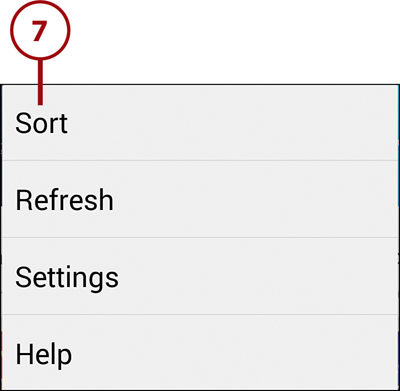
8. Touch the way you want to sort: Recently Read, Title, or Author. The Play Books app displays the books in that sort order.

9. Touch a book to open it. If the book is not stored on your Galaxy Note 3, Play Books downloads the book and then opens it.

Get Books from the Play Store
The Books area of the Play Store offers a fair number of e-books for free and a much larger number of e-books for sale. You can access the Books area of the Play Store easily from the Play Books app.
1. Touch the button in the upper-left corner of the Play Books app to display the navigation panel.
2. Touch Shop to display the Books area of the Play Store. The Play Books Home screen appears first.

3. Touch to search for books.
4. Touch to see the list of top-selling books.
5. Touch to see books that have been newly added to the Play Store.
6. Touch a featured book or a recommended book to see its details.
7. Touch a featured category to see the list of books it contains.
8. Touch to display the list of categories. You can also swipe right once from the Home screen to display the list of categories.

Navigate Quickly Among Tabs by Swiping
The Books area of the Play Store contains various tabs, including Categories, Home, Top Selling, New Arrivals in Fiction, New Arrivals in Nonfiction, and Top Free. You can navigate among these tabs by tapping their names on the tab bar, but it is usually quicker to swipe left or right one or more times to change tabs.
9. Touch the category you want to display. The Featured list for the category appears first.

10. Swipe up to see more of the list.
11. Touch the New Arrivals tab or swipe left to see the New Arrivals list for the category.
12. Touch a book to display its details.
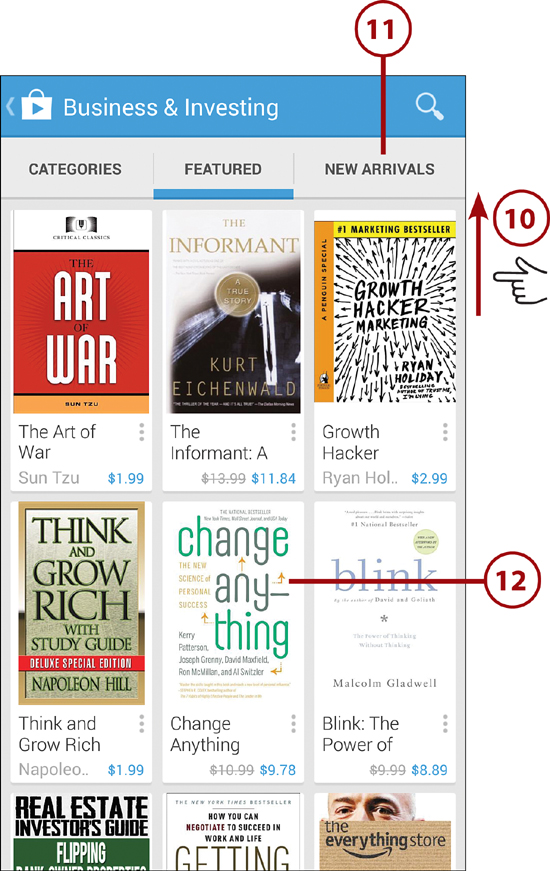
13. Touch to add the book to your wish list.
14. Touch Rate & Review to rate or review the book. You would normally do this after reading the book, but many raters and reviewers skip the reading step.
15. Touch to expand the description.
16. Swipe up to read the reviews, to see the Users Also Viewed list of books that may interest you if this one does, and to read the About the Author blurb.
17. Touch Free Sample to download a free sample of the book. Reading the sample can be a great way to decide whether to spend the money on the book. Android downloads the book and displays its first page in the Google Books app.
18. Touch the price button to buy the book, and then follow through the payment process on the next screen. If the book is free, touch the Open button. Android downloads the book and displays its first page in the Play Books app.
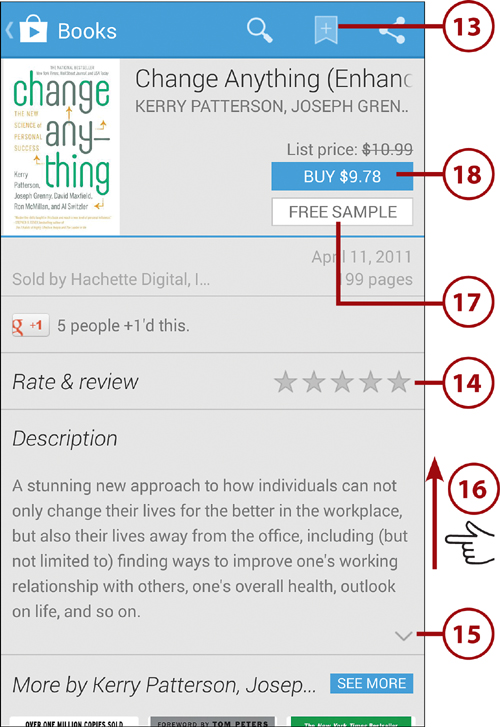
Buying Books from the Play Store
To buy a book from the Play Store, you must either add a credit card to your Google account or redeem a voucher. When you begin to buy a book, the Play Store app prompts you to add a credit card and walks you through the steps for adding it.
Share a Book with Other People
When you find a book you simply must tell someone about, you can do so easily from the Play Store app. Touch the Share button in the upper-left corner of the screen to display the Share dialog, touch the means of sharing you want to use, and then complete the sharing in the app that Android opens.
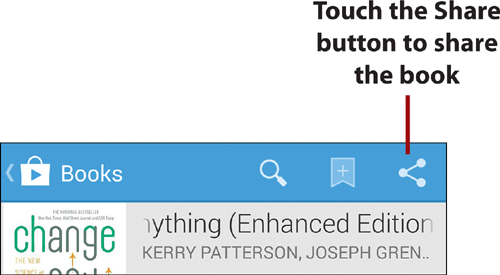
Finding Free E-Books Online
Apart from buying e-books online at Google’s Play Store or other stores such as Amazon (www.amazon.com) and Barnes & Noble (www.barnesandnoble.com), you can find many books for free. Most online stores offer some free e-books, especially out-of-copyright classics, so it is worth browsing the Free lists. Other good sources of free e-books include ManyBooks.net (www.manybooks.net) and Project Gutenberg (www.gutenberg.org).

Read Books with the Play Books App
1. In the navigation panel of the Play Books app, touch Read Now to display your Read Now screen. This screen shows the books you have been reading recently plus books you have recently bought (or downloaded for free) or uploaded to your Google account. Further down the screen is a Recommended for You section that suggests books you might be interested in based on the books you have.

2. Touch the book you want to open. The cover or default page appears if this is the first time you have opened the book. Otherwise, the page at which you last left the book appears.

3. Touch the middle of the screen to display the navigation controls at the top and bottom of the screen. The controls remain onscreen for a few seconds and then disappear if you do not use them. You can make them disappear more quickly by touching the screen again.
4. Touch to search within the book for specific text.
5. Touch to display the Contents screen. From here, you can touch Chapters to display a list of the book’s chapters and major headings, and then touch the place you want to display; or touch Bookmarks to display a list of the bookmarks you have created in the book, and then touch the bookmark you want to go to.
6. Drag to move quickly through the book.
7. Touch the right side of the screen or drag left to turn the page forward. Dragging lets you turn the page partway to peek ahead.

8. Touch the left side of the screen or drag right to turn the page back.

Choose Options for the Play Books App
You can configure the Play Books app to make it work your way. Options include switching between flowing text and the original pages of the book, adding bookmarks, and having your Galaxy Note 3 read aloud to you.
1. With the Play Books app open and active, touch the Menu button.
2. Touch Buy to buy the book in the Play Store. This command appears only when you are reading a sample of a book.
3. Touch About This Book to display the book’s page in the Play Store.
4. Touch Share to share the book’s URL on the Play Store via Facebook, Gmail, Twitter, or another means of sharing.
5. Touch Add Bookmark to add a bookmark to the current page. To remove the bookmark, go to the page, touch the Menu button, and then touch Remove Bookmark.
6. Touch Help to display the Help dialog, from which you can access various help resources, such as Help Center, Contact Us, or Report a Problem.
7. Touch Display Options to open the Display Options panel.

8. Touch to choose among the Day theme, the Night theme, and the Sepia theme. The Day theme uses black text on a white background; the Night theme uses white text on a black background; and the Sepia theme uses black text on a sepia background.
9. Touch to change the typeface used.
10. Touch to change the text alignment. The choices are Default, Left, and Justify.
11. Touch to enable or disable automatic brightness.
12. Drag to adjust the brightness manually.
13. Touch to decrease the font size.
14. Touch to increase the font size.
15. Touch to decrease the spacing between lines.
16. Touch to increase the spacing between lines.
17. Touch the book page to close the Display Options panel.

18. Touch the Menu button.
19. Touch Settings to display the Settings screen.

20. Touch Account if you need to change the Google account you are using for the Play Books app.
21. Touch Auto-Rotate Screen if you want to specify how to control rotation. In the Auto-Rotate Screen dialog that opens, touch Use System Setting, Lock in Portrait, or Lock in Landscape, as appropriate.
22. Touch to enable or disable restricting the Play Books app to downloading over Wi-Fi. Enable this restriction if your cellular plan gives you only a miserly data allowance.
23. Touch to enable using the volume key on the side of the Galaxy Note 3 to turn the pages in the Play Books app. This setting can be helpful if you normally hold your phone with your fingers over the volume key.
24. Touch to enable or disable the 3-D effect for turning pages. Disable this effect if you don’t like it.
25. Touch to enable or disable the Galaxy Note 3’s capability to read text aloud for you. You need to turn on the TalkBack feature in Accessibility settings to get reading aloud to work; see Chapter 2, “Customizing Your Samsung Galaxy Note 3,” for details.
26. Touch to leave the Settings screen and return to the screen you were previously using in the Play Books app.
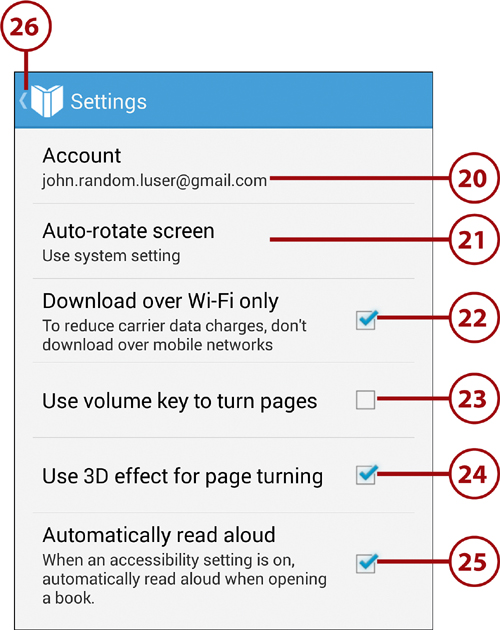
Delete a Book from Your Play Books Library
When you no longer want a particular book in your library, you can delete it directly using the Play Books app. Note that deleting the book removes it from your Google Play library entirely, not just from your Galaxy Note 3 (or whichever other device you’re using).
1. In the My Library view in Play Books app, touch the Menu button that appears on the book’s listing.
2. Touch Delete from Library. The Delete from Library confirmation dialog opens.
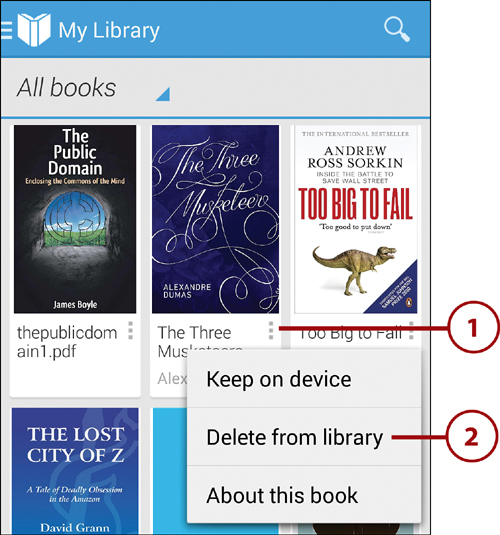
3. Touch Delete.
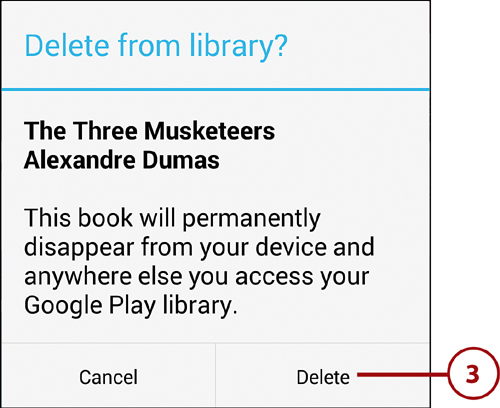
Install the Kindle App
Google’s Play Store has a good selection of books, but if you want to buy or download books from Amazon’s vast bookstore, you need to use the Kindle app instead. If you already own any Kindle books, installing the Kindle app gives you most of the benefits of owning a Kindle reader without having to buy or haul around an extra device.
Installing the Kindle App
If the Kindle app is not already installed on your Galaxy Note 3, you need to install it from the Play Store. Touch Play Store on the Apps screen, touch Apps on the Google Play screen, touch the Search icon, and type kindle. Touch the Kindle result and then touch Install.
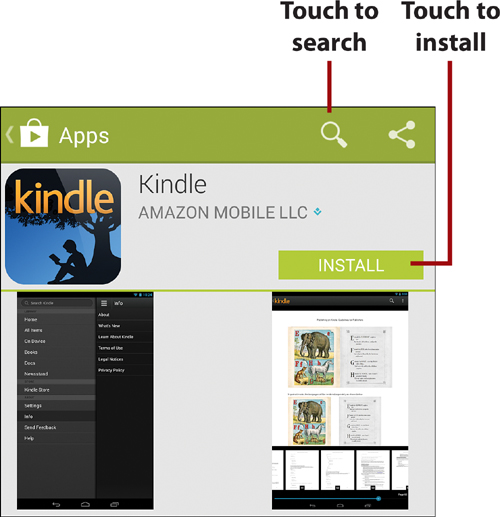
Sign In and Navigate the Kindle App
1. On the Apps screen, touch the Amazon Kindle icon. The first time you run the Kindle app, it displays the Start Reading screen.
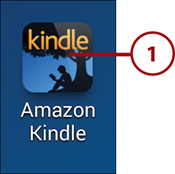
2. Touch the Sign In button to sign in to your existing account. The Sign In to Start Reading screen appears.
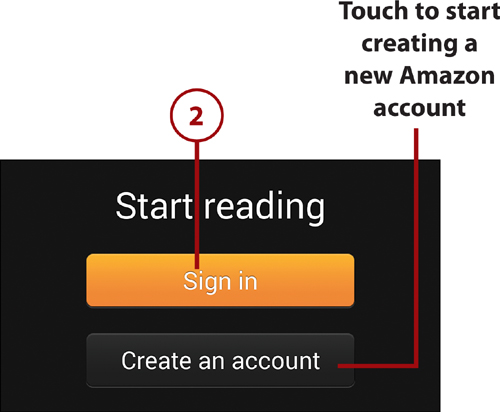
Creating an Amazon Account
To buy books or download free books from Amazon, you must have an Amazon account. If you do not have one, touch the Create an Account button on the Start Reading screen and then follow through the screens to create an account.
4. Type your Amazon password.
5. Touch Sign In. The Kindle app signs you into your account and then displays its Home screen. The books in your Kindle library appear on a carousel.

6. Touch to refresh the display of books. You would do this if you have just bought a book using your computer or a different device and the book hasn’t yet appeared on the Kindle app on your Galaxy Note 3.
7. Touch to go to the Kindle Store to browse or buy books.
8. Touch to display the navigation panel.
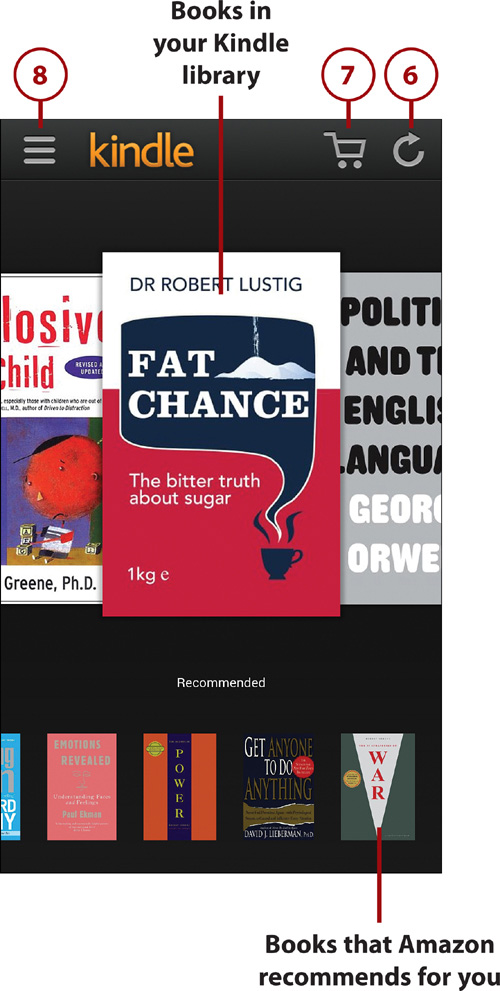
9. Touch Search Kindle to search your Kindle library for the terms you type.
10. Touch Home to display the Kindle Home screen.
11. Touch All Items to display the All Items screen. This screen shows all the items in your Kindle library, whether they are on your Galaxy Note 3 or not.
12. Touch On Device to see the list of books and other items stored on your Note 3.
13. Touch Books to see the list of books, rather than documents, newspapers, and magazines.
14. Touch Docs to display the documents stored in your Kindle account. These are documents you have sent via email to your Send to Kindle email address, a Kindle-only address that Amazon provides with Kindle accounts.
15. Touch Newsstand to display your Newsstand items.
16. Touch Kindle Store to go to the Kindle Store.
17. Touch Settings to display the Settings screen for configuring the Kindle app.
18. Touch Info to display information about Kindle and the Kindle app.
19. Touch Send Feedback to send feedback to Amazon.
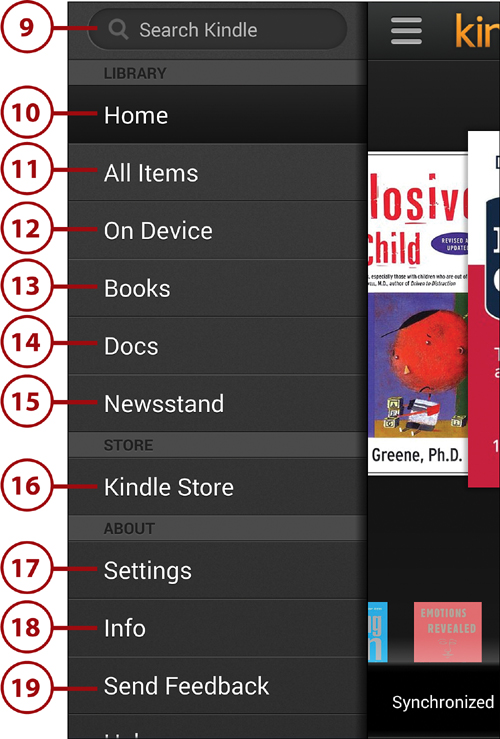
Read a Book with the Kindle App
1. In the Kindle app, touch the book you want to open. This example uses the On Device screen, but you can also start from another screen, such as the Home screen or the All Items screen.


Reaching the On Device Screen from a Book
If you currently have a book open in the Kindle app, touch the Back button to go back to the main screens and then touch On Device. Alternatively, touch the Menu button, touch Home to display the Kindle Home screen, and then touch On Device.
2. Touch the middle of the screen to display the title and location bar. Touch again to hide these items.
3. Drag the slider to change the location in the book.
4. Touch the right side of the screen to display the next page. You can also display the next page by dragging or swiping left.
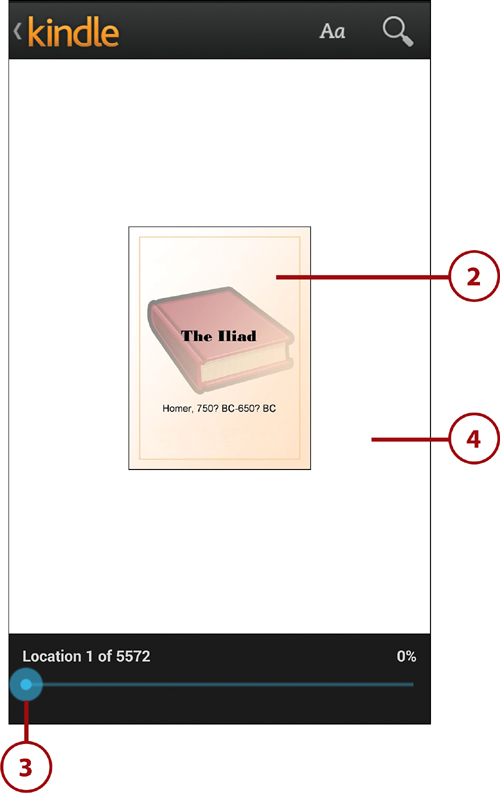
5. Touch the left side of the screen, or drag or swipe right, to move back a page.
6. Touch the Menu button to display the menu.
7. Touch Share Progress to display the Share Progress dialog, in which you can pick a way to share your reading progress. For example, you can post a link to Facebook or send an email message saying you’re 50% through the book.
8. Touch Add a Bookmark to bookmark the current page. Adding a bookmark gives you an easy way to return to a particular page by using the View My Notes & Marks command on the menu.
9. Touch Sync to Furthest Page Read to go to the furthest page you’ve read in this book on any of your Kindle devices. Normally, you’ll want to do this after reading on another device.
10. Touch View My Notes & Marks to view the list of notes and bookmarks you have added to the current book. From there, you can touch one of your bookmarks or notes to go to its page.
11. Touch Shop in Kindle Store to go shopping for Kindle books.
12. Touch Go To to display the Go To dialog.
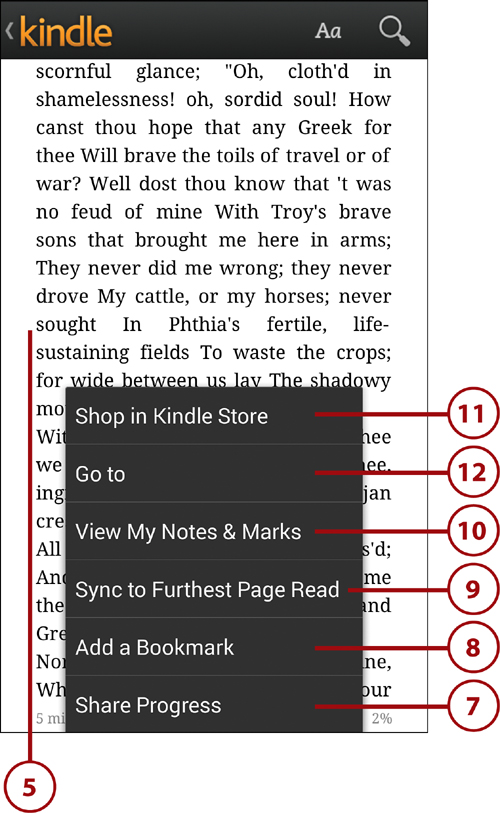
13. Touch to display the cover.
14. Touch to display the table of contents. This command is unavailable if the book has no table of contents.
15. Touch to go to the beginning of the text, after the cover.
16. Touch to go to a page by number. If the book does not have page numbers, this command is unavailable.
17. Touch to go to a location. The locations are numbered divisions of the text. You can see the number of the current location by touching the middle of the screen and looking at the Location slider. But unless you know the number of the location to which you want to go, this command is of little use.

Choose View Options for the Kindle App
To make your books easy to read, you can choose view options for them.
1. With a book open in the Kindle app, touch the screen to display the controls.
2. Touch to display the View Options panel.
3. Touch to decrease the font size.
4. Touch to increase the font size.
5. Touch to adjust the space between lines.
6. Touch to adjust the margin width.

7. Touch to choose the color scheme: White, Sepia, or Black.
8. Drag to adjust the brightness.
9. Touch the document to close the View Options panel.

Reading Magazines with Play Magazines
Your Galaxy Note 3 includes Google’s Play Magazines app, which gives you access to a wide range of magazines.
Exploring Other Magazine Apps
If the Play Magazines app does not deliver the content you need, or does not otherwise suit you, explore other magazine apps such as PressReader and Zinio. You can download both these apps for free from the Apps section of the Play Store.
Open the Play Magazines App and Choose Your Magazines
1. On the Apps screen or in the Google folder, touch Play Magazines. The app may open in either Read Now view, showing magazines you have read and ones you have added recently, or in My Library view, showing your entire magazine library.

2. Touch the button in the upper-left corner to open the navigation panel.
3. Touch Shop to display the Magazines section of the Play Store.

4. Touch to see the list of top-selling magazines. You can also swipe left once from the Home screen.
5. Touch to see the list of newly released magazines. You can also swipe left twice from the Home screen or once from the Top Selling screen.
6. Touch a featured magazine or a recommended magazine to see its details.
7. Touch a featured category to see the list of magazines it contains.
8. Touch to display the list of categories. You can also swipe right to display the list of categories.
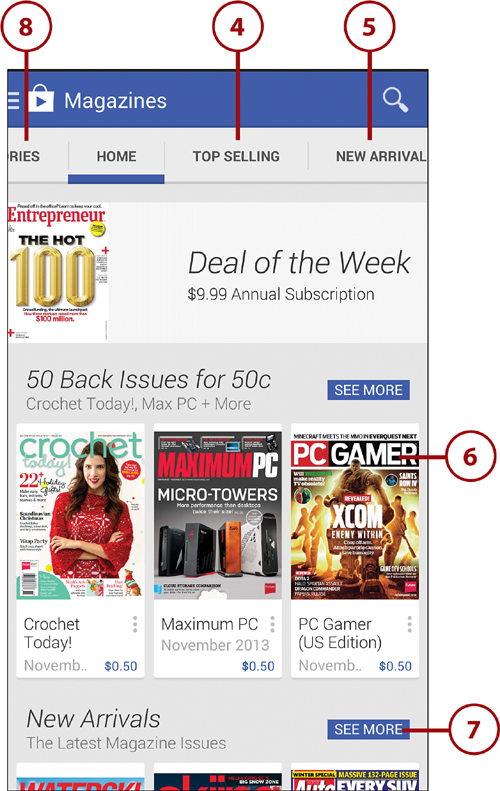
9. Touch the category you want to display.

10. Swipe up to see more of the list.
11. Touch New Arrivals or swipe left to see the New Arrivals list for the category.
12. Touch a magazine to display its details.

13. Touch to add the magazine to your wish list.
14. Touch Rate & Review to rate or review the magazine.
15. Swipe up to read the reviews and to see the Similar Magazines list, which might contain magazines that interest you. At the bottom of the screen, you also find the Back Issues list.
16. Touch Subscribe to start a 14-day trial subscription to the magazine, followed by a paid subscription if you do not cancel it. You can choose between a yearly subscription and a monthly subscription. Android downloads the magazine and displays its first page in the Google Magazines app.
17. Touch the price button to buy the magazine, and then follow through the payment process on the next screen. If the magazine is free, touch the Open button. Android downloads the magazine and displays its first page in Google Magazines.
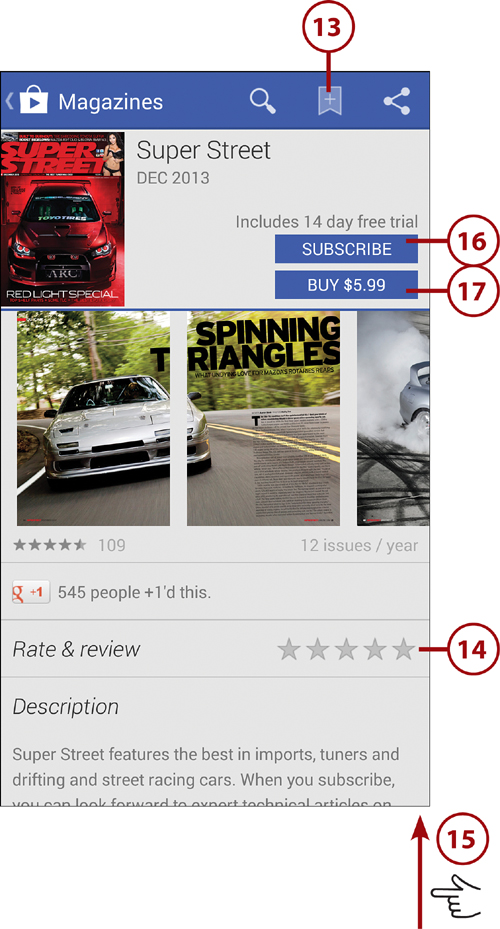
Read a Magazine with the Play Magazines App
1. On either the Read Now screen or the My Library screen in the Play Magazines app, touch the magazine you want to open. The cover appears if this is the first time you have opened the magazine. Otherwise, the page at which you last left the magazine appears.

2. Touch the middle of the screen to display the navigation controls at the top and bottom of the screen. The controls remain onscreen for a few seconds and then disappear if you do not use them. You can make them disappear more quickly by touching the screen again.
3. Touch to display a text-only version of the magazine. The text-only version can be much easier to read on your Galaxy Note 3’s screen, but only some magazines have a text-only version.
4. Drag the thumbnails to scroll through the pages.
5. Touch to display the next page.
6. Touch a page’s thumbnail to display that page.
7. Touch to display a table of contents.

8. Touch an article to display the page that contains it.

9. Double-tap or pinch outward with two fingers to zoom the page as needed.
10. Swipe left to display the next page or swipe right to display the previous page.

Choose Options for the Play Magazines App
The Play Magazines app has several settings you can choose to control when it downloads magazines and when it notifies you about new issues. You can also change the account you use to pay for Play Magazines.
1. From the Read Now screen or the My Library screen in the Play Magazines app, touch the Menu button.
2. Touch Settings.

3. Touch to change the account used for Play Magazines.
4. Touch to enable or disable automatic downloading of all your magazine purchases and subscriptions.
5. Touch to enable or disable limiting magazine downloads to when your Galaxy Note 3 has a Wi-Fi connection. Because magazine files can be relatively large, checking this box is a good idea if your cellular data plan is limited.
6. Touch to allow Play Magazines to show you notifications about new issues or to prevent it from doing so.
7. Touch to return to the previous screen.
